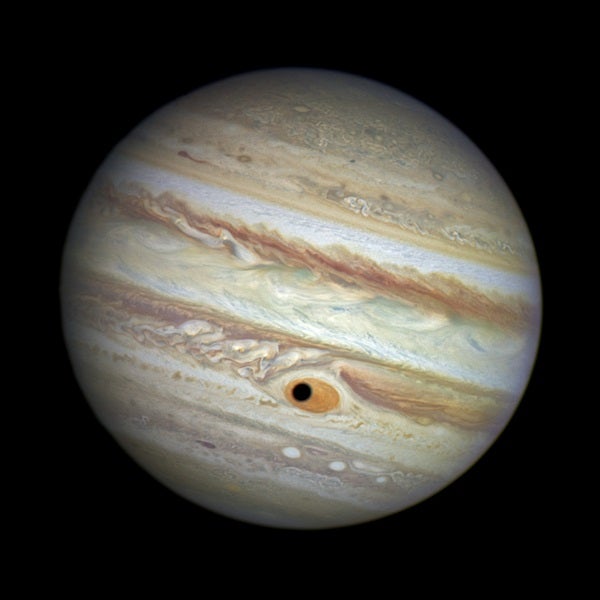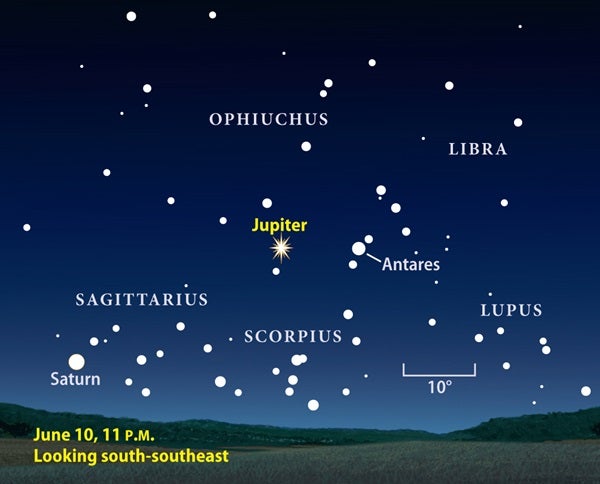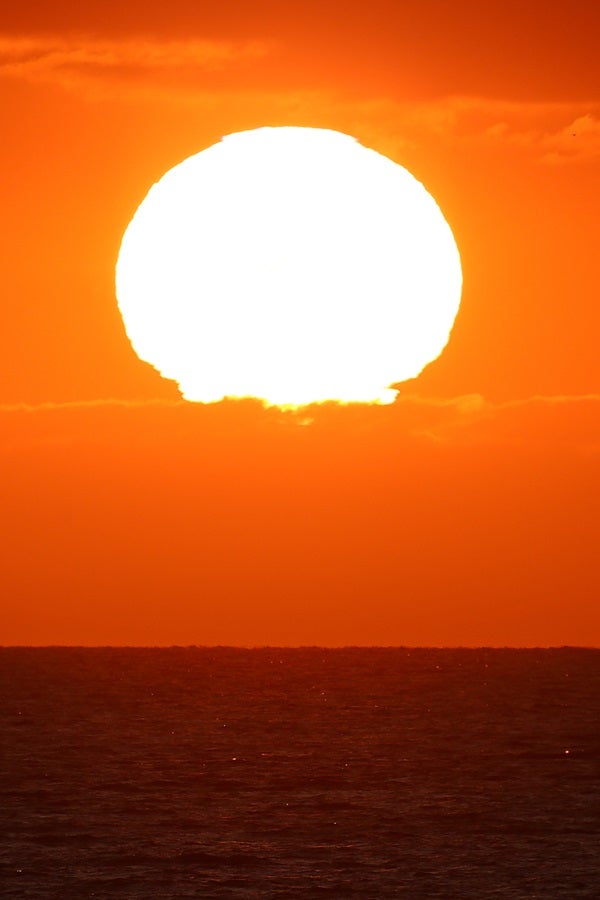Mars continues its eastward trek against the backdrop of Gemini the Twins this week. Shining at magnitude 1.8, the Red Planet appears slightly fainter than the constellation’s brightest stars, Castor and Pollux. Mars lies nearly 15° high in the west-northwest 45 minutes after sundown and doesn’t set until 10:30 p.m. local daylight time. If you turn a telescope on the planet, you’ll see a featureless disk that spans just 4″. You can use Mars as a guide to finding Mercury tonight. With binoculars in hand, scan 9° to Mars’ lower right and some 7° above the horizon. The inner planet shines at magnitude –0.6 and appears obvious to the naked eye once you know where to look. A telescope reveals Mercury’s 6″-diameter gibbous disk. The two planets approach each other as the week progresses, and Mercury will become an easier target than Mars. A week from tonight, magnitude –0.1 Mercury stands 2.5° to its neighbor’s lower right.
The Moon reaches perigee, the closest point in its orbit around Earth, at 7:15 p.m. EDT. It then lies 228,978 miles (368,504 kilometers) away from us.
Saturday, June 8
Venus pokes above the horizon in the east-northeast an hour before sunrise. The brilliant planet shines at magnitude –3.8 and appears conspicuous in the predawn sky as twilight brightens. If you view the inner planet through a telescope, you’ll see a nearly full disk that spans 10″.
Sunday, June 9
The First Quarter Moon hangs high in the southwest as darkness falls, then sinks steadily toward the western horizon throughout the evening hours. Our satellite officially reaches First Quarter phase at 1:59 a.m. EDT tomorrow morning (10:59 p.m. PDT tonight). The Moon lies in southern Leo, some 10° southwest of 2nd-magnitude Denebola and nearly twice as far east-southeast of 1st-magnitude Regulus.
Brilliant Jupiter reaches opposition and peak visibility tonight. It rises in the southeast at sunset and climbs highest in the south around 1 a.m. local daylight time. Shining at magnitude –2.6, the giant planet is the night’s brightest celestial object with the exception of the waxing gibbous Moon and Venus, which doesn’t rise until morning twilight is well underway. Jupiter resides among the background stars of southern Ophiuchus the Serpent-bearer. When viewed through a telescope, the gas giant’s disk spans 46″ and shows incredible detail in its cloud tops. You’ll also see the planet’s four bright moons. Io, Europa, and Ganymede line up in that order east of Jupiter while Callisto is the lone moon west of the planet.
Tuesday, June 11
Look high in the northwest after darkness falls this week and you’ll be greeted by the familiar sight of the Big Dipper. You can use the dipper — the sky’s most conspicuous asterism, a recognizable pattern of stars that doesn’t form a complete constellation shape — to find two of the spring sky’s brightest stars. If you follow the curve of the handle to the south, you’ll easily spot Arcturus. This magnitude 0.0 star, which belongs to Boötes the Herdsman, lies some 30° from the end of the Big Dipper’s handle. It is the fourth-brightest star in the whole sky and the second- brightest visible from mid-northern latitudes. And if you continue the curve another 30° past Arcturus, you’ll arrive at magnitude 1.0 Spica, the luminary of Virgo the Maiden. An easy way to remember the two is with the phrase: “Follow the arc to Arcturus, then drive a spike to Spica.”
Jupiter’s moons put on a show tonight, as both Io and Ganymede cross the planet’s disk. With the gas giant just a day past opposition, however, the shadow that each satellite casts falls onto the jovian cloud tops almost directly beneath the moon. Io’s transit begins at 10:22 p.m. EDT. Within five minutes, you should notice its shadow immediately to the moon’s east, with the two overlapping. Ganymede lies north of Io and begins to transit at 11:28 p.m. Its shadow falls on the cloud tops just southeast of the moon. Because Ganymede lies farther from Jupiter than Io, its shadow appears slightly more separated from the moon. Io completes its transit at 12:33 a.m., when Ganymede is about halfway across the giant planet’s disk. The outer moon completes its trek around 1:40 a.m.
Wednesday, June 12
Once you use the Big Dipper to find Arcturus, you’re well on the way to locating the 9th-magnitude asteroid 2 Pallas. From Arcturus, move 6.4° west-northwest to 5th-magnitude 6 Boötis, then another 2.4° northwest to 6th-magnitude 2 Boo. Tonight, Pallas lies 3.0° west-northwest of 2 Boo and right next to a 9th-magnitude field star. If you watch these two for a couple of hours, you’ll notice Pallas shifting position, confirming its identity as a solar system member.
For people who live near 35° north latitude, today marks the earliest sunrise of the year. Although the Northern Hemisphere’s longest day doesn’t occur until Earth’s summer solstice June 21, earliest sunrise happens several days before and latest sunset several days after. The specific dates depend on your latitude, however. In general, earliest sunrise occurs closer to the solstice the farther north you live.
Friday, June 14
Grab your binoculars tonight and target the bright star Regulus in the constellation Leo the Lion. Many people know that this object represents the Lion’s heart, but few realize it also is a binocular double. Regulus B, which glows at 8th magnitude, shows up as a pinpoint nearly 3′ from the 1st-magnitude primary. The pair stands about 20° high in the west once darkness falls.
Saturday, June 15
Although Saturn won’t reach opposition and peak visibility until next month, observers will be hard-pressed to see its current appearance as inferior. The ringed planet rises around 10 p.m. local daylight time and appears highest in the south around 3 a.m. Saturn shines at magnitude 0.2 and stands out against the background stars of northern Sagittarius. If you target the beautiful world through a telescope, you’ll see its 18″-diameter disk surrounded by a ring system that spans 41″ and tilts 24° to our line of sight.
Sunday, June 16
Full Moon officially arrives at 4:31 a.m. EDT tomorrow morning, but it looks completely illuminated all night. It appears low in the southeast as the Sun sets and climbs highest in the south around 1 a.m. local daylight time. The Full Moon resides among the background stars of southeastern Ophiuchus, though residents in western North America will see it slide into western Sagittarius by daybreak. You can expect a lot of people to ask what that bright object sitting next to the Moon is. Brilliant Jupiter lies just 5° from the Moon after sundown and a couple of degrees farther away by daybreak.












